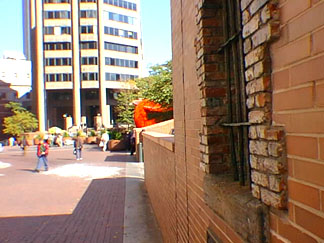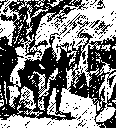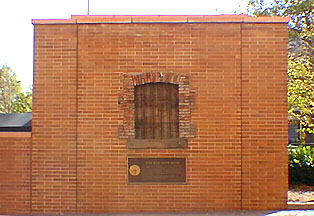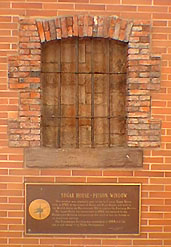British Prison Wall Stands in Park Here *
By John McNamara
* From the Archives (4/16/59) of the Riverdale Review and Bronx Press Review
During the British occupation of New York (1776-1783) the Rhinelander Sugar House was turned
into a notorious prison.

|
|
The Revolutionary War POW window memorial is situated near NYPD Hq seen above. [Window photos by NYCHS.]
|
This was a brick warehouse into which American prisoners of war and private citizens, suspected of helping the patriots, were thrown. Sanitary conditions were frightful and starvation was a constant threat, so that its evil reputation was well earned, and its death toll unbelievably high.
After the War, many prominent families moved uptown and the character of the neighborhood changed for the worse. It became a slum area, and the old Sugar House was regarded with awe
and superstition . . . (Using present day directions, the Sugar House stood at the southwest corner of Rose and Duane Sts. - which, today,
is in the shadow of the Municipal Building.) Many tales were told of wraithlike figures seen behind the barred windows, and of ghostly hands stretched out to midnight passersby. For well over a century the deserted warehouse was judged to be haunted . . .
In 1892, the Sugar House was demolished . . . An 11 - storied loft building was erected on the site, called the Rhinelander Building, and, with rare foresight, a barred window of the original warehouse and some of the ancient Holland bricks were set into the wall of
the modern building. These, and a descriptive plaque, can be seen to this day.
But what has this to do with the Bronx? A section of the old Sugar House wall and a barred window were transported to Van Cortlandt Park and set up near the Van Cortlandt Mansion. . . .
On a sunny day, the visitor finds the ivy-clad facade historically interesting, but if he were to return to that spot on a moonless night he would wonder if the ghosts of Revolutionary soldiers might not still be earth-bound to the old Sugar House wall. Low lying mist, floating
wraithlike through the barred window, looks uncannily like writhing figures, and trails of fog from nearby Van Cortlandt Lake swirl around the ancient wall like Continental military capes.
Prison Memorials of NYC: Untold Story of America's First POWs *
By James Renner
* From the Archives (July & August 1999 ) of the Washington Heights & Inwood Report
One of the least known and least spoken about subjects of the Americans Revolution were rebel Prisoners of War who were jailed in New York City. . . . New York City had become the main site for the prisoners was because it was the only city to be held by the British for the duration of the war. Many of the prisoners were from the Battle of Long Island on August 26, 1776 (1,300) and from the Battle of Fort Washington on November 16, 1776 (3,000).


|
|
British Provost Marshal William Cunningham, who ruled POW prisons in NYC, personally presided at and took pleasure in the execution of American patriots, including Nathan Hale whose statue (above) in City Hall Park is near the Sugar House Prison window memorial. Many of those executions took place on Barracks St., now called Chambers St. also near it. [NYCHS sketch conversions]
|
During the occupation of New York by the Royalist forces many prisoners had been filled the British commandeered barns, churches, taverns, private homes and sugar houses for trials and incarcerations. The lack of space in New York City was compounded by the filling of the jails with rebels and by two great fires during the autumn of 1776 thus forcing the occupation forces to use converted ships. The man responsible for the prisons on land and in the water was Provost Marshal William Cunningham. In lower Manhattan one of the most famous prisoners was the Rhinelander Sugar Warehouse located near Liberty Street. The warehouse was built in 1763 and was demolished in 1875. The only remnant of this building is a window salvaged from the factory and set into a memorial behind the Municipal Building located at Centre and Chambers Streets.
Noted examples of private homes in northern Manhattan used as temporary prisons were the Morris-Jumel and the Dyckman Farmhouse . . . .
During the occupation of New York City by the British, it was estimated that 11,000 prisoners perished on the ships. The brutality on these ships had inflicted untold suffering in an unprecedented scale. Flogging and other acts of violence had run rampant on the ships. Overcrowding, starvation, and disease (smallpox, dysentery, typhus and yellow fever) was of epidemic proportions. Many of the prisoners dared their guards to kill them. . . .
On the average there had been 11 ships used as prisoners in the waters of the Hudson and East Rivers. By the end of the war a total of 25 ships had been used as prisons. . . .
The most famous and notorious prison ship was the H.M.S. Jersey, a 64 gun veteran British warship that was unfit for naval service was partially dismantled and converted to house the rebel prisoners. The JERSEY, located in Wallabout Bay (now the Brooklyn Navy Yard), held about 1,100 men and gave up about 6 to 8 bodies per day. The chances of survival on board the JERSEY were less than 1 out of 5.

|
Audible but hardly visible behind the Sugar House Prison Memorial and its nearby trees is the exit ramp of the Brooklyn Bridge at City Hall and the Municipal Building. The preserved prison window was called to the attention of the NY Correction History Society by a member of its board of trustees, Thomas Antenen, NYPD Deputy Commissioner for Public Information.
|
The Prison Ship Martyr's Monument was erected in Fort Greene Park Brooklyn. The park and surrounding area was named for General Nathaniel Greene who was instumental in the design and construction of Fort Washington in Manhattan and Fort Lee in New Jersey. The locale was the site of Fort Putnam, one of a chain of forts used by the Rebel Army in the battle of Long Island. . . . The Martyr's Monument, designed by Stanford White . . . is the most austere and moving of the war memorials in New York City. It was dedicated on November 18, 1908 with President William Howard Taft in attendance. . . .
Lower Manhattan boasts another monument to honor the American prisoners. In Trinity Churchyard and cemetery on Broadway and Wall Streets is a memorial where American soldiers of the Revolution are remembered. This monument was erected by the Vestry of the Church in 1852 and is located in the north-eastcorner of the cemetery. It is a sandstone tower designed in the Gothic-Revival style. This monument honors the unknown American soldiers and sailors of the Revolutionary War who were imprisoned and died and were buried in unmarked graves during the occupation of New York by the British.
|
 The mind's eye could imagine spirits of Revolutionary War patriots peering through the centuries-old British military prison bars encased in a wall near Police Plaza and the Municipal Building across from City Hall. It's a relic of the Sugar House Prison where hundreds of American POWs died of starvation and disease. Now hundreds of New Yorkers pass it daily, hurrying to and from business, never once stopping to read the plaque beneath the bars. Usually the memorial draws attention only from tourists with guidebooks and from New Yorkers with a passion for their city's history. The latter include historians John McNamara, James Renner and editors of the newspapers (logos shown) that published their excellent essays referencing the preserved prison window. NYCHS thanks them for permission to present these excerpts.
The mind's eye could imagine spirits of Revolutionary War patriots peering through the centuries-old British military prison bars encased in a wall near Police Plaza and the Municipal Building across from City Hall. It's a relic of the Sugar House Prison where hundreds of American POWs died of starvation and disease. Now hundreds of New Yorkers pass it daily, hurrying to and from business, never once stopping to read the plaque beneath the bars. Usually the memorial draws attention only from tourists with guidebooks and from New Yorkers with a passion for their city's history. The latter include historians John McNamara, James Renner and editors of the newspapers (logos shown) that published their excellent essays referencing the preserved prison window. NYCHS thanks them for permission to present these excerpts.





